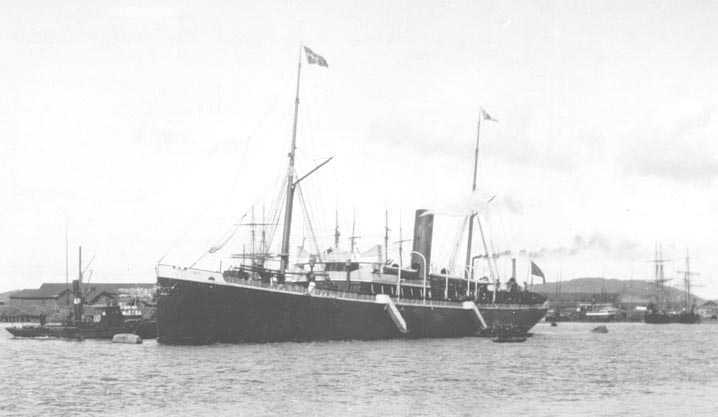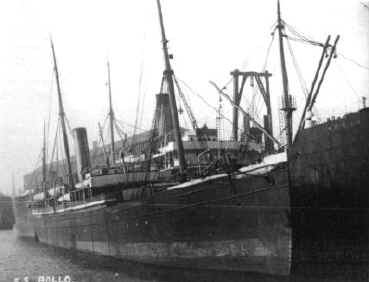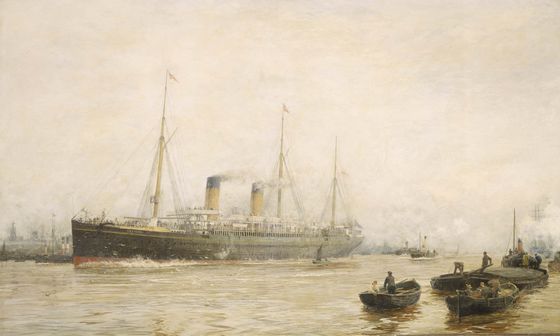


| ||
| Ariosto | Rollo | Romeo |



| ||
| Ariosto | Rollo | Romeo |

Emigrant Waiting Room of the North Eastern Railway Company
at the Hull Paragon Railway Station
The three ships, pictured above, brought five children of PETER OLSSON to America in the late 1880's and 1890's. During the peak of the emigration, ships like these left from Göteborg every week, usually on Friday afternoon. Once underway, the trip to Hull took about 40 to 50 hours. The ships usually approached the eastern coast of England during the day or early evening of the following Sunday. The primary port city was Kingston-upon-Hull, commonly referred to as Hull. It was the home of the Wilson Line, which owned these three ships. The final hours of the journey took the immigrants up the River Humber where they would dock at the wharf.
By the 1890's immigrant's transportation facilities in Hull had been improved greatly. During the preceeding decades, the immigrants would disembark from the ships and stroll around town. The also had to walk through town to get to the train stations. An outbreak of Cholera, in 1866, led to new rules and procedures. The rail tracks were brought closer to the wharf, and the railway companies built waiting rooms to hold the large number of immigrant passengers. The immigrants remained on board their ship until shortly before the departure time of their trains.
The trains left for Liverpool on Monday morning around 11:00 AM, arriving in Liverpool between 2:00 and 3:00 PM. The route took them through Leeds and Manchester, giving them a glimpse of those two thriving cities. The trains were filled solely with immigrants. The ticket purchased back in Sweden included the trip to Hull, the train to Liverpool, and then the steamship to America. CHARLES paid 62 kronor and 50 ören, about a year's wages.
Physically the three ships are quite similar. They were 260-300 feet in length, 30-40 feet wide, with an 18-20 foot draft. The Rollo was built in 1870, expressly for passenger transportation between Göteborg and Hull. The Romeo was built in 1881, and the Ariosto in 1890. They were single engine with a single funnel, capable of cruising at 11-12 knots. They held about 40-50 1st class passengers, 20-30 2nd class, and about 500 in steerage.


| Majestic | Teutonic |
The Teutonic and Majestic were sister ships built for the White Star Line. Both were built with financial help of the British government with the stipulation that the Royal Navy could have access to them in the event of war.
The Teutonic was launched first, in 1889, followed the next year by the Majestic. In July 1891, the Majestic established a speed record for crossing the Atlantic and earned the Blue Riband Award. The following year the Majestic beat the record and took the award away. The fastest times were just under 6 days. Both records were short-lived, as the following year the "City of Paris" set a new record.
The ships were nearly identical, 582 feet in length, and 57.7 feet in width. They were powered by two engines and could make 20 knots. The capacity of each was 1490 passengers - 300 1st class, 190 2nd class, and 1,000 steerage. At the time of launch, the Teutonic was the world's largest ship and the first White Star whip without sails.
Axel Peterson was aboard the Majestic when it sailed from Liverpool on May 3, 1893. This was a Wednesday, the usual departure date. Axel had been in Liverpool nine days, missing the departure a week earlier, probably because of overbooking. He arrived in New York on May 10. He would have disembarked at Manhattan and boarded a ferry for Ellis Island, which opened the previous year.
Two years after Axel's trip, a new captain was assigned to the Majestic. His name was Edward Smith. He would later become famous, as in 1904 he captained the Titanic on its maiden voyage.
In 1898, Augusta Peterson crossed the Atlantic on the Teutonic. As a single female she had more privileges than Axel. She arrived in Liverpool, and then sailed from there two days later. The ships were always crowded. If not full when they left Liverpool they would stop at Queenstown (Cobh), Ireland, and "top off the load." From Queenstown it was 2,600 miles of open sea to New York.
| Ship from Sweden | Departure Date | Name | Ship to America | Arrival Date | Sponsor/Destination |
|---|---|---|---|---|---|
| Rollo | May 7, 1886 | Sven Fredrik Peterson | |||
| Romeo | Apr 24, 1891 | Johanna E. Peterson | |||
| Ariosto | Sep 18, 1891 | Ulrika Dahl | |||
| Ariosto | Apr 15, 1892 | KARL (CHARLES) PETERSON | |||
| Romeo | May 6, 1892 | Sven Fredrik Peterson & Selma | |||
| Rollo | Apr 21, 1893 | Axel Peterson | Majestic | May 10, 1893 | Duluth |
| Romeo | Aug 12, 1898 | Augusta Peterson | Teutonic | Aug 24, 1898 | Sofia Peterson / 214 Madison Ave, NY |